Drawing Water From The Soil By Plant Roots Is Known As
Learning Objectives
- Explain water potential and predict movement of water in plants by applying the principles of water potential
- Describe the effects of different environmental or soil conditions on the typical water potential gradient in plants
- Identify and describe the three pathways water and minerals can take from the root hair to the vascular tissue
- Explain the three hypotheses explaining water movement in plant xylem, and recognize which hypothesis explains the heights of plants beyond a few meters
Water Transport from Roots to Shoots
The information below was adapted from OpenStax Biology 30.5
The structure of plant roots, stems, and leaves facilitates the transport of water, nutrients, and photosynthates throughout the plant. The phloem and xylem are the main tissues responsible for this movement. Water potential, evapotranspiration, and stomatal regulation influence how water and nutrients are transported in plants. To understand how these processes work, we must first understand the energetics of water potential.
Water Potential
Plants are phenomenal hydraulic engineers. Using only the basic laws of physics and the simple manipulation of potential energy, plants can move water to the top of a 116-meter-tall tree. Plants can also use hydraulics to generate enough force to split rocks and buckle sidewalks. Plants achieve this because of water potential.

With heights nearing 116 meters, (a) coastal redwoods (Sequoia sempervirens) are the tallest trees in the world. Plant roots can easily generate enough force to (b) buckle and break concrete sidewalks, much to the dismay of homeowners and city maintenance departments. (credit a: modification of work by Bernt Rostad; credit b: modification of work by Pedestrians Educating Drivers on Safety, Inc.) Image credit: OpenStax Biology
Water potential is a measure of the potential energy in water, specifically, water movement between two systems. Water potential can be defined as the difference in potential energy between any given water sample and pure water (at atmospheric pressure and ambient temperature). Water potential is denoted by the Greek letter Ψ (psi) and is expressed in units of pressure (pressure is a form of energy) called megapascals (MPa). The potential of pure water (Ψpure H2O) is designated a value of zero (even though pure water contains plenty of potential energy, that energy is ignored). Water potential values for the water in a plant root, stem, or leaf are expressed relative to Ψpure H2O.
The water potential measurement combines the effects ofsolute concentration(s) andpressure (p):
Ψ system = Ψs + Ψp
where Ψs = solute potential, and Ψp = pressure potential. Addition of more solutes willdecreasethe water potential, and removal of solutes will increase the water potential. Addition of pressure willincreasethe water potential, and removal of pressure (creation of a vacuum) willdecrease the water potential.
Water always moves from a region ofhighwater potential to an area oflow water potential, until it equilibrates the water potential of the system. At equilibrium, there is no difference in water potential on either side of the system (the difference in water potentials is zero). In order for water to move through the plant from the soil to the air (a process called transpiration), Ψsoil must be > Ψroot > Ψstem > Ψleaf > Ψatmosphere.
Let's consider solute and pressure potential in the context of plant cells:
- Solute potential (Ψ s ), also called osmotic potential, is negative in a plant cell and zero in distilled water, because solutes reduce water potential to a negative Ψs. The internal water potential of a plant cell is more negative than pure water because of the cytoplasm's high solute content. Because of this difference in water potential, water will move from the soil into a plant's root cells via the process of osmosis. This is why solute potential is sometimes called osmotic potential.Plant cells can metabolically manipulate Ψs by adding or removing solute molecules.
-
Pressure potential (Ψ p), also called turgor potential, may be positive or negative. Positive pressure (compression) increases Ψ p, and negative pressure (vacuum) decreases Ψ p. Positive pressure inside cells is contained by the rigid cell wall, producing turgor pressure. Pressure potentials can reach as high as 1.5 MPa in a well-watered plant. A Ψ p of 1.5 MPa equates to 210 pounds per square inch (psi); for a comparison, most automobile tires are kept at a pressure of 30-34 psi. A plant can manipulate Ψ p via its ability to manipulateΨ s and by the process of osmosis. If a plant cell increases the cytoplasmic solute concentration, Ψ s will decline, water will move into the cell by osmosis, andΨ p will increase.Ψ p is also under indirect plant control via the opening and closing of stomata. Stomatal openings allow water to evaporate from the leaf, reducing Ψ p and Ψ total of the leaf and increasing the water potential difference between the water in the leaf and the petiole, thereby allowing water to flow from the petiole into the leaf.
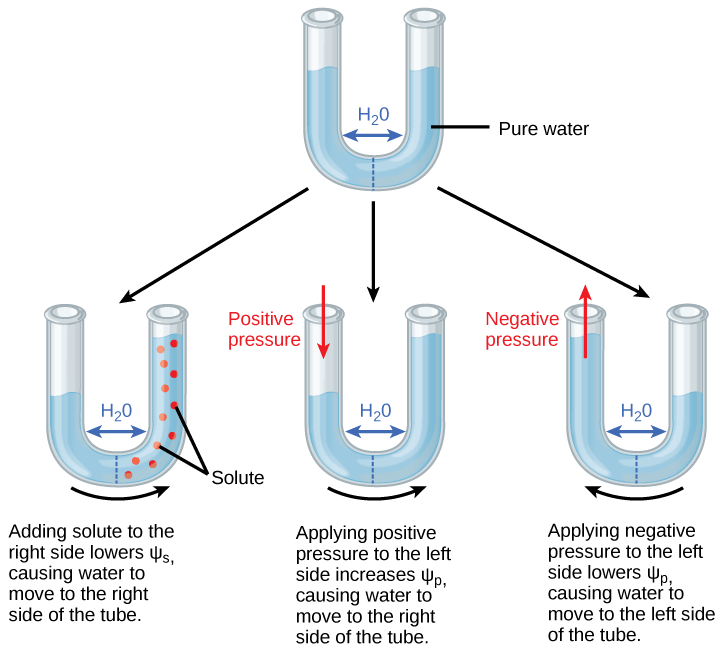
In this example with a semipermeable membrane between two aqueous systems, water will move from a region of higher to lower water potential until equilibrium is reached. Solutes (Ψs) and pressure (Ψp) influence total water potential for each side of the tube. Water moves in response to the difference in water potential between two systems (the left and right sides of the tube). Image credit: OpenStax Biology.
An example of the effect of turgor pressure is the wilting of leaves and their restoration after the plant has been watered. Water is lost from the leaves via transpiration (approaching Ψ p = 0 MPa at the wilting point) and restored by uptake via the roots.
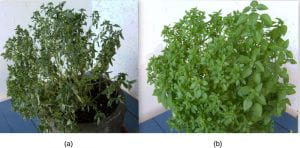
When (a) total water potential (Ψ) is lower outside the cells than inside, water moves out of the cells and the plant wilts. When (b) the total water potential is higher outside the plant cells than inside, water moves into the cells, resulting in turgor pressure (Ψp) and keeping the plant erect. (Image credit: OpenStax Biology, modification of work by Victor M. Vicente Selvas).
This video provides an overview of water potential, including solute and pressure potential (stop after 5:05):
And this video describes how plants manipulate water potential to absorb water and how water and minerals move through the root tissues:
Movement of water and nutrients in the roots
Negative water potential continues to drive movement once water (and minerals) are inside the root; Ψ of the soil is much higher than Ψ or the root, and Ψ of the cortex (ground tissue) is much higher than Ψ of the stele (location of the root vascular tissue).Once water has been absorbed by a root hair, it moves through the ground tissue through one of three possible routes before entering the plant's xylem:
- thesymplast: "sym" means "same" or "shared," so symplast is shared cytoplasm. In this pathway, water and minerals move from the cytoplasm of one cell in to the next, via plasmodesmata that physically join different plant cells, until eventually reaching the xylem.
- thetransmembrane pathway: in this pathway, water moves through water channels present in the plant cell plasma membranes, from one cell to the next, until eventually reaching the xylem.
- theapoplast: "a" means "outside of," so apoplast is outside of the cell. In this pathway, water and dissolved minerals never move through a cell's plasma membrane but instead travel through the porous cell walls that surround plant cells.
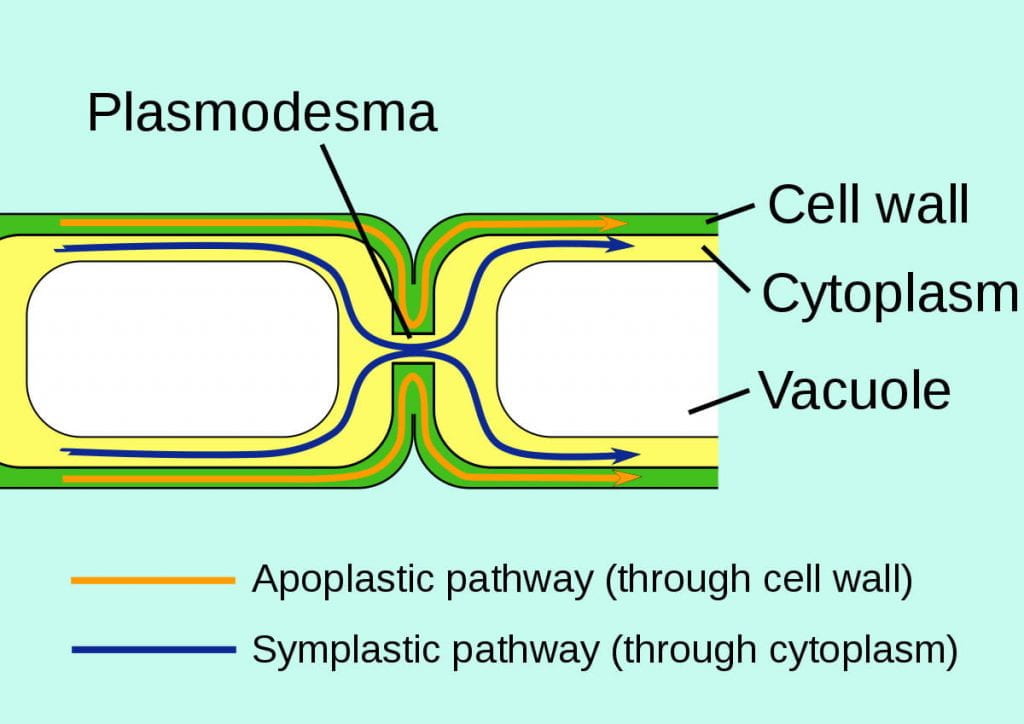
By Jackacon, vectorised by Smartse – Apoplast and symplast pathways.gif, Public Domain, https://commons.wikimedia.org/w/index.php?curid=12063412
Water and minerals that move into a cell through the plasma membrane has been "filtered" as they pass through water or other channels within the plasma membrane; however water and minerals that move via the apoplast do not encounter a filtering step until they reach a layer of cells known as the endodermis which separate the vascular tissue (called the stele in the root) from the ground tissue in the outer portion of the root. The endodermis is exclusive to roots, and serves as a checkpoint for materials entering the root's vascular system. A waxy substance called suberin is present on the walls of the endodermal cells. This waxy region, known as the Casparian strip, forces water and solutes to cross the plasma membranes of endodermal cells instead of slipping between the cells. This ensures that only materials required by the root pass through the endodermis, while toxic substances and pathogens are generally excluded.
This image was added after the IKE was open:
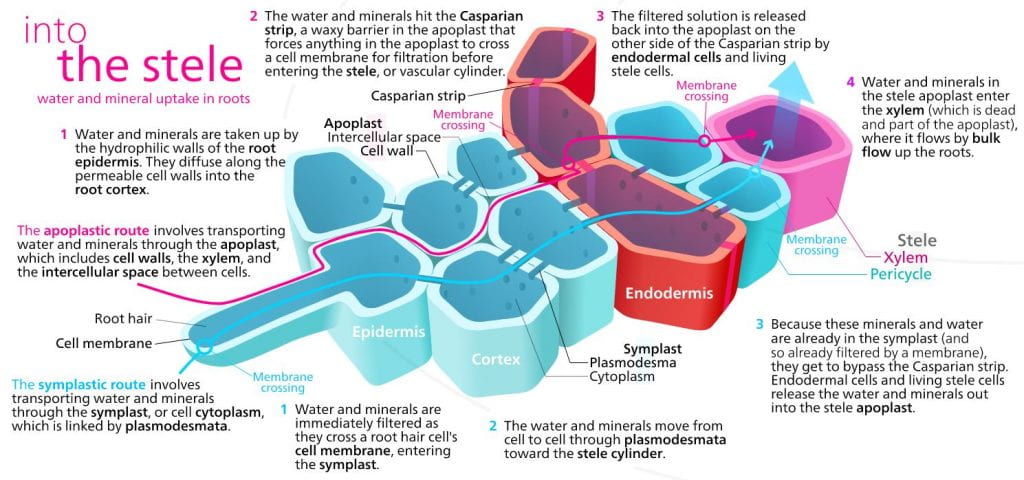
Water transport via symplastic and apoplastic routes. By Kelvinsong – Own work, CC BY-SA 3.0, https://commons.wikimedia.org/w/index.php?curid=25917225
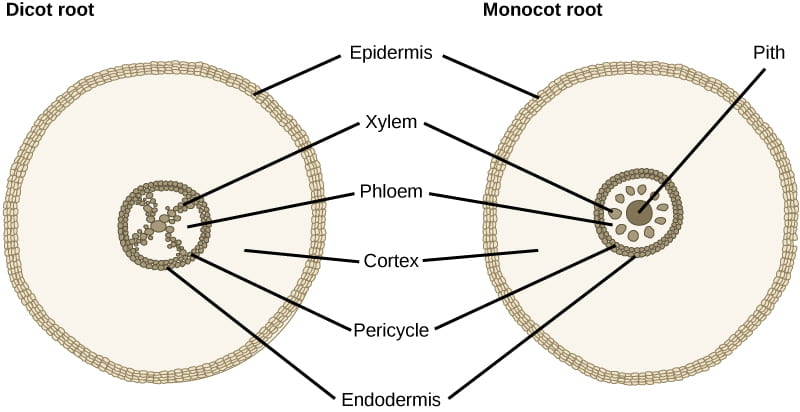
The cross section of a dicot root has an X-shaped structure at its center. The X is made up of many xylem cells. Phloem cells fill the space between the X. A ring of cells called the pericycle surrounds the xylem and phloem. The outer edge of the pericycle is called the endodermis. A thick layer of cortex tissue surrounds the pericycle. The cortex is enclosed in a layer of cells called the epidermis. The monocot root is similar to a dicot root, but the center of the root is filled with pith. The phloem cells form a ring around the pith. Round clusters of xylem cells are embedded in the phloem, symmetrically arranged around the central pith. The outer pericycle, endodermis, cortex and epidermis are the same in the dicot root. Image credit: OpenStax Biology.
Movement of Water Against Gravity
How is water transported up a plant against gravity, when there is no "pump" to move water through a plant's vascular tissue? There are three hypotheses that explain the movement of water up a plant against gravity. These hypotheses are not mutually exclusive, and each contribute to movement of water in a plant, but only one can explain the height of tall trees:
- Root pressure pushes water up
- Capillary action draws water up within the xylem
- Cohesion-tension pulls water up the xylem
We'll consider each of these in turn.
Root pressure relies on positive pressure that forms in the roots as water moves into the roots from the soil. Water moves into the roots from the soil by osmosis, due to the low solute potential in the roots (lower Ψs in roots than in soil). This intake o f water in the roots increasesΨp in the root xylem, driving water up. In extreme circumstances, root pressure results in guttation, or secretion of water droplets from stomata in the leaves. However, root pressure can only move water against gravity by a few meters, so it is not strong enough to move water up the height of a tall tree.
Capillary action or capillarity is the tendency of a liquid to move up against gravity when confined within a narrow tube (capillary). Capillarity occurs due to three properties of water:
- Surface tension, which occurs because hydrogen bonding between water molecules is stronger at the air-water interface than among molecules within the water.
- Adhesion, which is molecular attraction between "unlike" molecules. In the case of xylem, adhesion occurs between water molecules and the molecules of the xylem cell walls.
- Cohesion, which is molecular attraction between "like" molecules. In water, cohesion occurs due to hydrogen bonding between water molecules.
On its own, capillarity can work well within a vertical stem for up to approximately 1 meter, so it is not strong enough to move water up a tall tree.
This video provides an overview of the important properties of water that facilitate this movement:
The c ohesion-tensionhypothesis is the most widely-accepted model for movement of water in vascular plants. Cohesion-tension essentially combines the process of capillary action withtranspiration, or the evaporation of water from the plant stomata. Transpiration is ultimately the main driver of water movement in xylem. The cohesion-tension model works like this:
- Transpiration (evaporation) occurs because stomata are open to allow gas exchange for photosynthesis. As transpiration occurs, it deepens the meniscus of water in the leaf, creating negative pressure (also called tension or suction).
- The tension created by transpiration "pulls" water in the plant xylem, drawing the water upward in much the same way that you draw water upward when you suck on a straw.
- Cohesion (water sticking to each other) causes more water molecules to fill the gap in the xylem as the top-most water is pulled toward the stomata.
Here is a bit more detail on how this process works: Inside the leaf at the cellular level, water on the surface of mesophyll cells saturates the cellulose microfibrils of the primary cell wall. The leaf contains many large intercellular air spaces for the exchange of oxygen for carbon dioxide, which is required for photosynthesis. The wet cell wall is exposed to this leaf internal air space, and the water on the surface of the cells evaporates into the air spaces, decreasing the thin film on the surface of the mesophyll cells. This decrease creates a greater tension on the water in the mesophyll cells, thereby increasing the pull on the water in the xylem vessels. The xylem vessels and tracheids are structurally adapted to cope with large changes in pressure. Rings in the vessels maintain their tubular shape, much like the rings on a vacuum cleaner hose keep the hose open while it is under pressure. Small perforations between vessel elements reduce the number and size of gas bubbles that can form via a process called cavitation. The formation of gas bubbles in xylem interrupts the continuous stream of water from the base to the top of the plant, causing a break termed an embolism in the flow of xylem sap. The taller the tree, the greater the tension forces needed to pull water, and the more cavitation events. In larger trees, the resulting embolisms can plug xylem vessels, making them non-functional.
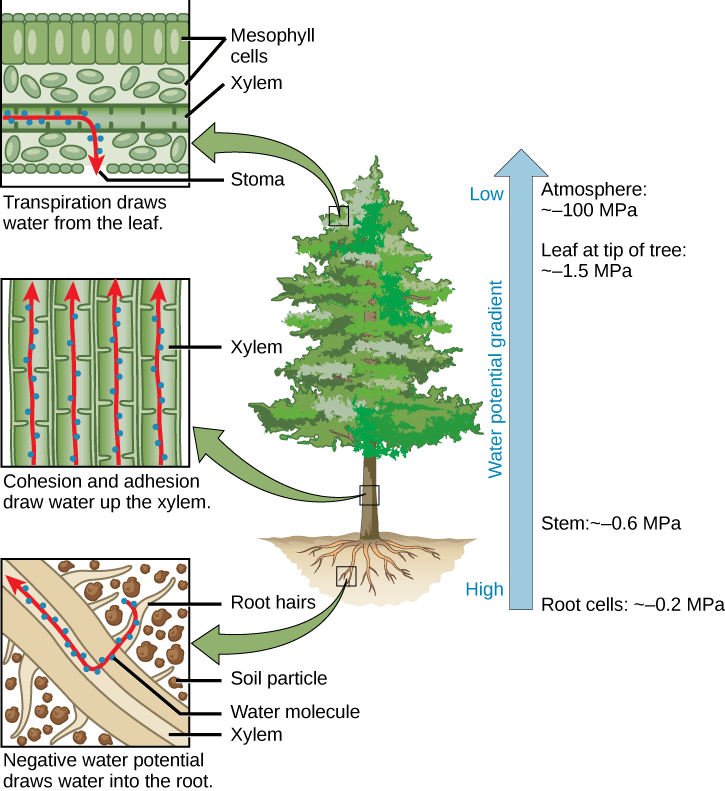
The cohesion-tension theory of sap ascent is shown. Evaporation from the mesophyll cells produces a negative water potential gradient that causes water to move upwards from the roots through the xylem. Image credit: OpenStax Biology
This video provides an overview of the different processes that cause water to move throughout a plant (use this link to watch this video on YouTube, if it does not play from the embedded video):
https://www.youtube.com/watch?v=8YlGyb0WqUw&feature=player_embedded
Control of Transpiration
Transpiration is a passive process, meaning that ATP is not required for water movement. The energy driving transpiration is the difference water potential difference between the water in the soil and the water in the atmosphere. However, transpiration is tightly controlled.
The atmosphere to which the leaf is exposed drives transpiration, but also causes massive water loss from the plant. Up to 90 percent of the water taken up by roots may be lost through transpiration.
Leaves are covered by a waxy cuticle on the outer surface that prevents the loss of water. Regulation of transpiration, therefore, is achieved primarily through the opening and closing of stomata on the leaf surface. Stomata are surrounded by two specialized cells called guard cells, which open and close in response to environmental cues such as light intensity and quality, leaf water status, and carbon dioxide concentrations. Stomata must open to allow air containing carbon dioxide and oxygen to diffuse into the leaf for photosynthesis and respiration. When stomata are open, however, water vapor is lost to the external environment, increasing the rate of transpiration. Therefore, plants must maintain a balance between efficient photosynthesis and water loss.
Plants have evolved over time to adapt to their local environment and reduce transpiration. Desert plant (xerophytes) and plants that grow on other plants (epiphytes) have limited access to water. Such plants usually have a much thicker waxy cuticle than those growing in more moderate, well-watered environments (mesophytes). Aquatic plants (hydrophytes) also have their own set of anatomical and morphological leaf adaptations.
Xerophytes and epiphytes often have a thick covering of trichomes or of stomata that are sunken below the leaf's surface. Trichomes are specialized hair-like epidermal cells that secrete oils and substances. These adaptations impede air flow across the stomatal pore and reduce transpiration. Multiple epidermal layers are also commonly found in these types of plants.
Drawing Water From The Soil By Plant Roots Is Known As
Source: https://organismalbio.biosci.gatech.edu/nutrition-transport-and-homeostasis/plant-transport-processes-i/
Posted by: smallhealf1997.blogspot.com

0 Response to "Drawing Water From The Soil By Plant Roots Is Known As"
Post a Comment